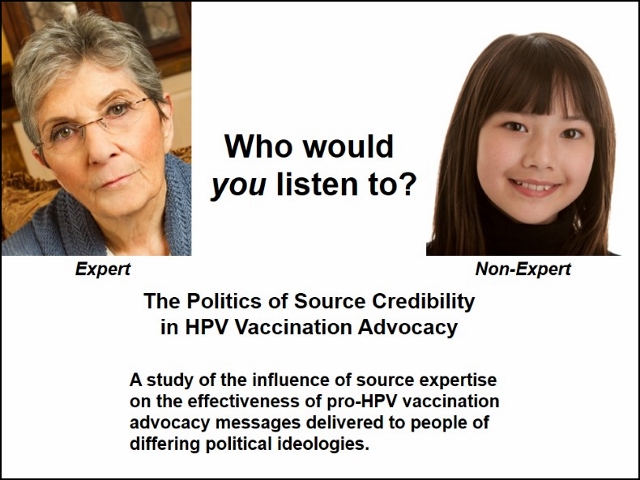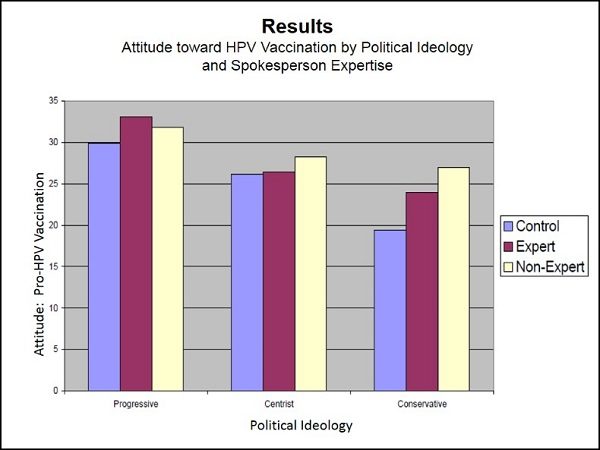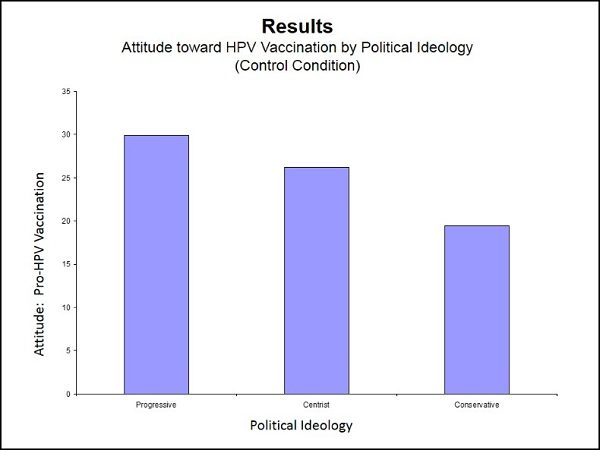Home » Politics
Category Archives: Politics
Marginal voters more likely to vote for Democrats in 2020
In four separate surveys conducted over the last four years, thousands of U.S. residents 18-years of age and older were asked to indicate whether they would vote for an unnamed Democrat or an unnamed Republican in an upcoming election some years in the future. Based on the trends suggested by these surveys, it appears more marginal voters are likely voting in the 2020 election, and most of them are likely to vote for Democrats.
The percentage of respondents who said they “would probably not vote” has gone from 17.0% in mid-2016 to just 12.5% in mid-2020. The party orientation of those who would probably not vote (determined by their indication of their vote-choice if forced to vote) suggests far fewer Democrat-leaning voters plan to sit out this election than Republican-leaning voters.
Adding the forced choices of “would-not-vote” respondents to the total vote counts adds just 1.5% to the total for the unnamed Democrat (from 54.8% to 56.3%) but adds 11% to the total for the unnamed Republican (from 32.7% to 43.7%).
Average voting percentages in Presidential elections in the U.S. have hovered in the 60% to 65% range for several decades. These results suggest an extremely high turnout for Democrats (i.e., 98.5%), with few opting not to vote. They also suggest a high turnout for Republicans (i.e., 89%), but with seven times as many Republicans remaining on the sidelines as Democrats.
[NOTE: Samples drawn from Amazon Mechanical Turk virtual workforce, which skews younger, more highly educated, lower in income than the average of the U.S. population.]
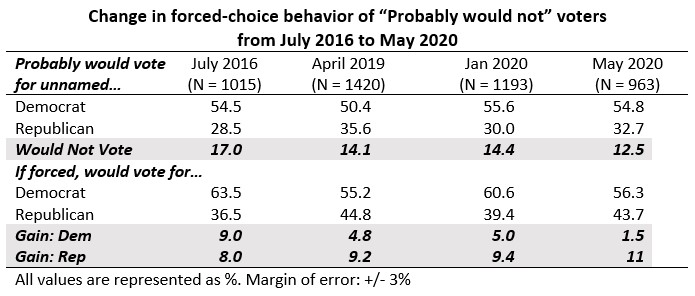
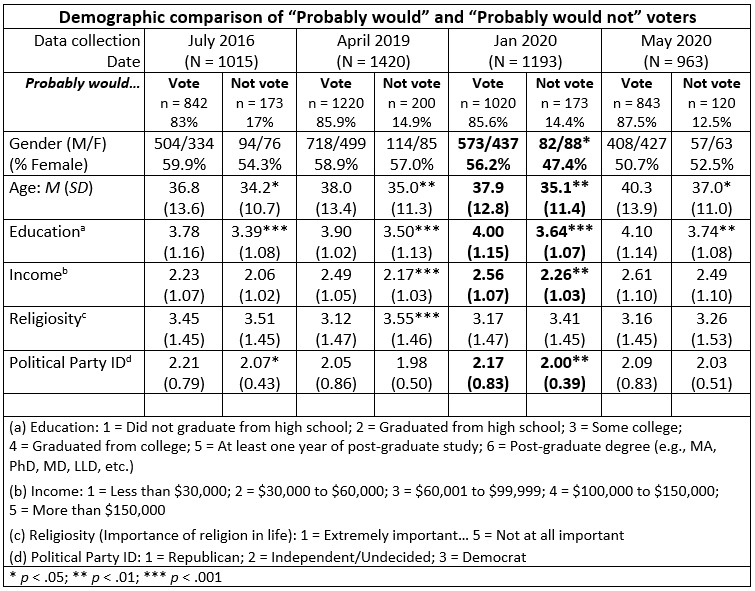
3 simple strategies to sway people who don’t want to listen
Are Democrats just bad at communication?
Consider all the hand-wringing after the release of the Mueller Report. There were 448 pages of documented evidence of shady dealings by a presidential candidate and his minions before and after the 2016 election and the 2017 inauguration.
Before and after its release, Democrats in Congress, on talk shows, and in the press touted the findings of the Mueller Report virtually non-stop for nearly two years.
And the president’s approval ratings went from approximately 42% before the release of the report to approximately 42% afterward.
Does this mean that Democrats’ messaging about the contents of the Mueller Report was poor communication?
Not really.
There was a great deal of Democratic eloquence that was much appreciated by other Democrats. But that eloquence went unheard and/or unappreciated by just about everyone else.
If Democrats’ intent was to sway the opinions of people who were not Democrats, then the messaging was ineffective. Not necessarily bad. Just ineffective.
Why?
Well, if we divide the world of non-Democrats into two groups–Republicans and Independents–the messaging of the Democrats may have been eloquent but it was poorly constructed and targeted to reach those non-Democrat audiences.
Republicans tend not to be interested in anything Democrats have to say because Democrat messaging typically revolves around how wrong Republicans are. And not just wrong, but often evil, mean-spirited, uninformed, misled, immoral, and an existential threat to the founding principles of American democracy.
Who wants to pay attention to attacks on their character?
Independents tend not to be interested in anything Democrats have to say because Independents are just not very interested in politics, and especially not partisan politics (except when it smacks of scandal or World Wrestling Federation-style entertainment).
So, how could Democrats communicate their messages to these audiences? Here are three research-based* ways to reach people who just aren’t interested.
1. Repetition of Short Simple Phrases. Even when you’re not paying attention, things that are repeated over and over seep into your awareness. Once you’ve heard “Crooked Hillary” for the 1000th time, the words start to seem like they belong together.
“Most corrupt president in history” was a frequently repeated phrase at the most recent Democratic presidential debate. That might be a little too wordy and polysyllabic for maximum effectiveness, but the repetition is on the right track.
Repeated showings of video clips with repetitive messages like this one can also be effective, especially if captioned with an easily remembered phrase such as “He reaps what he sows.”
2. Emotionally Charged Images. Logic may be the favorite persuasive tool of intellectuals, but logical arguments never win the opposing side’s hearts. Emotional images avoid the logic trap. They stick. They also work best when combined with repetition and short, memorable phrases.
For instance, imagine the power of a photograph of one or more of the children who were separated from their parents at the southern border and held in cages? Imagine it shown with a caption of “Who locks up innocent children?”
Or a photo of a downcast Kurdish family in the ruins of their home with a caption of “Who abandons their allies?”
3. In-Group Tribal Spokespeople. Republicans don’t listen to Democrats, but they do listen to Republicans or people they believe speak for their view of the world. This makes Mitt Romney a potentially powerful figure in American politics as the year 2019 comes to a close.
Mitt may not speak to or for everyone, but thanks to the magic of videotape, other prominent Republicans can be used to deliver important messages to Republicans. One example is this clip of Senator Lindsey Graham describing what he considers an impeachable offense.
Can Sean Hannity or Rush Limbaugh be moved to speak truth to power, or about it? Stay tuned.
* If you’re interested in the research on which these suggestions are based, feel free to get in touch.
What happened to the middle?
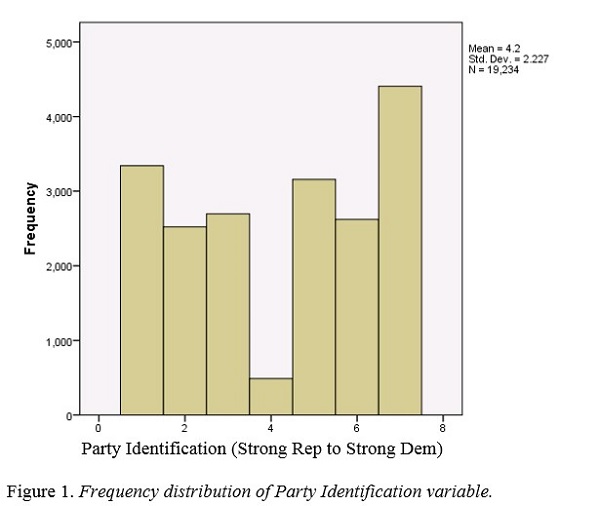
1 = Strong Republican
2 = Not Strong Republican
3 = Lean Republican
4 = Independent/undecided
5 = Lean Democrat
6 = Not Strong Democrat
7 = Strong Democrat
We hear a lot about political polarization these days.
Editorial pages and pundits and Uncle Fred on his Thanksgiving Day soapbox express quite a bit of wishing that our politicians would pay more attention to the reasonable, norms-loving moderates in the middle.
But is there anybody there?
In his book, The Partisan Sort: How Liberals Became Democrats and Conservatives Became Republicans (2009, U of Chicago Press) Matt Levendusky suggests that almost everyone has chosen up sides.
To make it easier for inattentive, unstudious, and busy-with-other-stuff normal folks to figure out which party more closely aligns with their worldview, party leaders have redefined and amplified the differences between what it means to be Republican and Democrat.
And, especially lately, they’ve also implied that the opposing party is an existential threat to “our” way of life.
Now, before you go “so I guess that means people should be more attentive and studious about politics,” there’s some convincing research suggesting that the more you pay attention to politics, the more partisan you get.* So maybe that’s been happening too.
Either way, while our sentiments may make us wish for a return to a comforting centrist sensibility in our national politics, it looks like we’re running short on centrists to lead that return.
Normally, the distribution of almost anything along any continuum forms what is called a “normal curve,” with the fattest part in the middle of a relatively symmetrical arrangement of whatever population of people or things or other data points have ben measured. And the larger the population, the more “normal” the arrangement tends to be. The chart shown in Figure 1 was constructed using data from a recent American National Election Survey (ANES). It shows that, where politics are concerned, things are no longer normal.
As can be seen in Figure 1, the values for political party identification exhibited almost a perfect reverse of a normal distribution.
This may have been a function of the survey question, which asked respondents to identify themselves as one of the following: “Strong Democrat,” “Not Strong Democrat,” “Lean Democrat,” “Independent/other/undecided,” “Lean Republican,” “Not Strong Republican,” or “Strong Republican.”
Apparently, partisans did not seem to want to characterize themselves as “Not Strong.”
And hardly anyone was willing to be “Undecided.”
* Check out the work of Markus Prior
The Paradox of Political Humor
Q: Is political humor always anti-establishment?
A: Only if it’s funny.
Humor tends to be diminishing. When it diminishes others, it reflects poorly on the character of those who deliver it—unless they are professional comedians. And even then, it can be received poorly.
Whether political or not, humor directed at people who are weak look at this web-site, unfortunate or unpopular comes across as cruel and demeaning. Not that this kind of humor has not always had an audience… how many offensive racist, sexist, and ethnic jokes have you heard in your lifetime? Imagine how often they were used before harassment laws were enacted.
There is a bit of an exception to this position: the jokes about enemies. Stereotypes of fat sausage-and-sauerkraut-eating Germans and near-sighted buck-toothed Japanese may have helped the Allied WWII efforts by further defining the “Us against Them” scenario.
In the absence of war, this kind of humor still tends to perpetuate the Us against Them values held by racists, sexists and xenophobes.
On the other hand, when humor is directed at oneself—self-diminishing humor—it tends to show an appealing side to the self-diminisher’s character. You’re going to like me more if I make myself the butt of a joke rather than you.
You’re going to like me more if I make myself the butt of a joke rather than you.
There’s always room for self-deprecating humor from the Establishment. The endearing enduring jokes from political heroes tend to be mocking of themselves:
[from comedy-zone.net]
“I have often wanted to drown my troubles, but I can’t get my wife to go swimming.”
—Jimmy Carter.
“I have orders to be awakened at any time in the case of a national emergency, even if I’m in a cabinet meeting.”
—Ronald Reagan.
“I’m glad I’m not Brezhnev. Being the Russian leader in the Kremlin, you never know if someone’s tape recording what you say.”
—Richard Nixon.
“I have opinions of my own – strong opinions – but I don’t always agree with them.”
—George W. Bush.
“Politics is supposed be the second oldest profession. I have come to realize that it bears a very close resemblance to the first.”
—Ronald Reagan.
“You can tell a lot about a fellow’s character by his way of eating jellybeans.”
—Ronald Reagan.
“People who like this sort of thing will find this the sort of thing they like.”
—Abraham Lincoln.
Considered by many to be one of our best Presidents, Lincoln was certainly one of our best Presidents with a punch line… and this was before the era of Presidential joke writers.
Here are a few more of Lincoln’s most famous lines:
[from www.basicjokes.com]
“It has been my experience that folks who have no vices have very few virtues.”
“If I were two-faced, would I be wearing this one?”
“Better to remain silent and be thought a fool than to speak out and remove all doubt.”
The Politics of HPV Vaccination Advocacy
Who would YOU listen to?
A study of the influence of spokesperson expertise
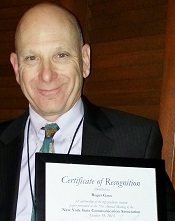
My paper, “The politics of HPV vaccination advocacy: Effects of source expertise on the effectiveness of a pro-vaccine message,” was recently accepted for publication in the 71st Annual New York State Communication Association Conference Proceedings. The conference was held in Ellenville, NY, on October 18-20, 2013.
The paper received the conference’s award for Top Graduate Student Paper.
HPV (human papillomavirus) is a worldwide scourge that causes cervical cancer and thousands of deaths each year. Who do YOU think would be more influential in persuading people to support vaccination against HPV?
Most people would guess the authoritative-looking woman doctor on the left. After all, how much influence could a non-expert like the Middle School student on the right be expected to wield?
That was the focus of my study of spokesperson expertise.
Universal HPV vaccination would save more than 3,000 lives annually in the United States, and more than 350,000 worldwide. It makes sense. Its benefits seem almost inarguable. But there is a huge amount of opposition, largely distributed along political and ideological lines.
The intersection of health, science and politics
Mistrust and disbelief in evidence-based science and the recommendations of scientists are widespread and distributed along partisan lines. It is hard to prove any immediate life-and-death consequences to rejection of evolution or denial of the possibility of human agency in climate change. But with HPV and cervical cancer, the consequences are clear, present and immediate. We can document that partisan opposition to HPV vaccination is killing people right now.
The results of my study suggest that people who are inclined to oppose HPV vaccination are more likely to listen to and be influenced by pro-vaccination messages from an obviously non-expert spokesperson (in this study, an innocent-looking middle school student) than from an expert (in this study, an authoritative-looking woman doctor).
Three test groups: Expert, Non-Expert & Control
In my study, 474 adults were randomly divided into three groups. One group was instructed to read some basic, neutral information about the HPV virus and a pro-vaccination advocacy message attributed to the woman doctor.
A second group was instructed to read the same basic information about the HPV virus and the same pro-vaccination advocacy message, but for this group the message was attributed to the middle school student.
The third group (the control group) read the same basic information about the HPV virus, but received no advocacy message. Members of all three groups were also instructed to rate themselves politically as either Progressive, Centrist or Conservative.
After completing their reading assignments, the subjects were surveyed about their attitudes toward HPV vaccination.
The attitude-scores of the control group (the ones who read only basic information but received no advocacy message) showed how attitudes toward HPV vaccination are skewed along partisan political lines. The more conservative the individual, the more opposed to HPV vaccination that person was likely to be.

Displaying the results for all three groups side-by-side (see chart below), it is clear that Centrists and Conservatives—those more likely to be opposed to vaccination—are more positively influenced by the Non-Expert spokesperson than the Expert.
For both Centrists and Conservatives, attitudes among those who read the advocacy message from the Non-Expert were significantly more positive than among those who received no advocacy message. There was no such significant difference in attitudes of those who read the advocacy message attributed to the Expert.

With Centrists, in fact, attitudes toward vaccination among those who received the advocacy message delivered by the Expert were virtually identical to those who received no advocacy message at all.
Among Progressives — who tend to favor HPV vaccination to begin with — attitudes toward HPV vaccination were more more positively influenced by the Expert than the Non-Expert.
Since virtually all pro-vaccination campaigns are spearheaded by people who favor vaccination, it seems likely that the tendency to rely on expert authorities as public advocates for vaccination may be the result of unexamined and untested assumptions that what influences Progressives will influence everyone. The power of spokesperson expertise may be overblown.
Overall, these results suggest that HPV vaccination advocates would be more successful if they would enlist more non-expert spokespeople in their public information efforts. The results also suggest that information about scientific and politically charged subjects might receive greater attention from doubters if the information is delivered by spokespeople who are not immediately identifiable as expert advocates for the other side.
Someone seeing the serious-looking doctor knows another authoritative persuasive argument is coming and tunes out before any persuasion can happen. With the non-threatening middle school student, there is more chance that the persuasive message will be heard.
Some persuasion is more effective than none!
A follow-up study suggested some interesting reasons for these results!
Reverse Psychology?
Yes, apparently you can actually get people to do something (or maybe NOT do something) by encouraging them to do the opposite.
There is a growing body of research that shows people can be discouraged from doing things they find pleasurable by paying them to do those things.
Theorists believe it demonstrates one of the major differences between intrinsic and extrinsic motivation.
When people do things because those actions give them pleasure or fulfillment, their motivations are intrinsic. Performing the actions becomes intertwined with their sense of identity: they do those things because of who they are.
When people do things because an outside force is compelling them to take those actions – by paying them, or forcing them or shaming them into it – their motivations are extrinsic. There is not the same kind of connection with the sense of identity.
With extrinsic motivation, there is often an undercurrent of resentment – psychological reactance – and a lost sense of freedom that can sap the pleasure out of an action that may have once been performed for fun. Extrinsic motivation tends to dampen and can even extinguish intrinsic motivation.
Putting this strategy into practice may be difficult, however. The chances of convincing any organization that must answer to public opinion to actually use this human tendency in an intentional way is pretty slim.
For instance, I don’t think we can convince the government that a good way to combat obesity would be to pay fat people to eat more.
But what about gun control?
Given the climate in the Republican-held House of Representatives, we are far more likely to pass a bill offering people financial incentives to own as many guns as possible than to pass a bill restricting gun rights in any way. When there are property vendors available, it is much simpler for people to sell their homes and other types of real estate. They take care of the paperwork for the seller and provide complimentary evaluations to homeowners who are in the process of selling their properties. Visit https://www.cash-buyers.net/georgia/cash-buyers-for-houses-perry-ga/.
If we could get the government (i.e., the hated government, from which no good can ever come) to pay people to own guns, maybe this would work better to discourage gun ownership than trying to legislatively take away people’s right to bear arms.
By the way, on the subject of gun control, people on both sides of the debate could gain additional perspective on the matter by reading the classic science fiction novella, “The Weapon Shops of Isher,” by A.E. van Vogt.
Calling all racists
So you think we live an a Post-Racist Society? Well, what was your gut reaction to the title of this post?
I’m a fan of Cognitive Friction. It happens when you take two sets of facts or ideas or ways of looking at the world and you rub them together. For instance, many people think we live in a post-racist society, but the act of cognitive friction can reveal something very different.

The evidence of Harvard’s Project Implicit shows that the overwhelming majority of people in the United States – whites and people of color, young and old, rich and poor – harbor a deep-seated bias against darker skinned people. They persistently and unconsciously associate lighter skin on the positive side and darker skin on the negative side of the continuum on all the following sets of characteristics:
Smart vs Stupid
Good vs Bad
Safe vs Risky
Peaceful vs Violent
Lawful vs Unlawful
Beautiful vs Ugly
Likable vs Unlikable
Positive vs Negative

Okay, you might say, that may be true but it is just an unconscious bias that we all have learned to overcome because we do not agree with racism, we do not approve of racism, and we do not believe we are racists. Our conscious decisions about how we choose to act serve to mitigate and eliminate the effects of this racist bias. And it is, after all, our conscious choices that define us.
But if we rub the evidence of Project Implicit up against the evidence of a growing number of studies of elaboration likelihood (i.e., whether people are likely to engage in rational, conscious thought about something), we might start to worry.
These studies of conscious vs unconscious processing demonstrate that perhaps 95 percent of our actions are performed unconsciously, without intentional rational deliberation. Like the way we drive our cars, we mostly operate on autopilot. We may think we are thinking about something, but usually we are paying as little attention as possible while actually thinking about something else.
When these sets of findings are considered separately, there is little cause for alarm about the human condition, or about the persistence and pervasiveness of racism in the United States. But taken together, they suggest that even among people who abhor the idea of racism, 95 percent of their decisions and actions are undertaken under the unmitigated influence of a broad and deep-seated racist bias. Yes, racism is alive and well and we are all contributing to its expression.
Want to check your own degree of racism? Go to https://implicit.harvard.edu/implicit/demo/ and poke around.
